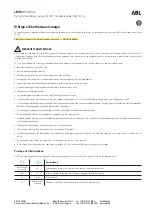
Vehicle Speed
Square Wave Characteristics
Specifications
Battery Voltage
Max High Signal
3.67 Volts
Min High Signal
1.1 Volts
Max Low Signal
- 1.1 Volts
Min Low Signal
+/- 1.0 Volts
Max Ground Offset
10µ sec <= tr <= 250µ sec
Rise Time
10µ sec <= tf <= 250µ sec
Fall Time
50% +/- 10%
Duty Cycle
2.2 Hz/MPH (1.3808 Hz/KPH)
Pulse Rate
WARNING: Do not interface with the CAN
(Controller Area Network) for vehicle
speed.
Pin 5 - Vehicle Speed signal is a direct current
coupled square wave that varies in frequency in
proportion to vehicle speed. This provides a square
wave-form (50% duty cycle) signal, where a
frequency of 138Hz equates to 100km/h.
Ignition
Pin 6 - Ignition signal is protected by a 10A fuse.
It is +12V active at ignition positions: Accessory
(1) and Run (2). It is not active at Ignition OFF (0)
or Crank (3). Whilst it can drive equipment directly
it is recommended to use this feed to control a
converter fitted relay, especially for high current
applications.
Switch Illumination
Pin 7 - Switch Illumination signal is only to be used
for sensing or to control a relay. It is a PWM signal
only for low current illumination 300mA max, that
can be dimmed and not to drive a relay.
Engine Run
WARNING: Do not cut into the alternator
wires or use the alternator as a source to
obtain a 'D+ Signal'.
Pin 2 - Engine Run signal will only support a sense
line or relay control.
This engine run signal is ground switching (max
current sink 250mA), it provides no positive output
(open circuit) and is only active when the engine
is running regardless of vehicle variant, for
example Start-Stop or SRC.
The signal will not be present when:
•
Key states - OFF (0), Accessory (1), Run but
Engine OFF (2), Crank (3).
•
Key in Run position, where Start-Stop vehicle
has auto stopped the engine.
•
Engine running but load is greater than 250mA
(driving two or more relays in error).
Due to Start-Stop vehicles, the signal may switch
up to 300,000 times. Provision is required for
control relays switched by this signal to meet this
durability cycle.
The fitment of the Auxiliary Fuse Panel will provide
a power +12V side for the relay (although
connection to the engine run pin is still required).
This allows up to 15A output on the C1 connector
with the manual demand switch Aux 2, see SVO
Auxiliary Fuse Panel circuit diagram later in this
section
If a positive (+12V) engine run signal is required,
it can be done by using the switched ground to
control an ignition fed relay, to give this output.
4.19.6 Auxiliary Fuse Panel (A526)
The Auxiliary Fuse Panel is recommended for
vehicle converters where access to fused power
connections are required (for example, additional
lighting), see figures E175190 and E175191. A
dedicated wiring harness (GK2V-14517-A* for left
hand drive and GK3V-14517-C* for right hand
drive) is used to implement the Auxiliary Fuse
Panel to the vehicle. This fuse panel is located
within the drivers seat pedestal as part of the Pre
Fuse Box (PFB). The Auxiliary Fuse Panel uses the
Vehicle Interface, shown in figure E226735 and
provides an advanced customer access point (C1)
connector as well as a (C2) interface connector
to further switch installations and a power and
ground supply.
Date of Publication: 03/2018
FORD
TRANSIT
2016.75
4 El
ec
tric
al
197
EU
















































